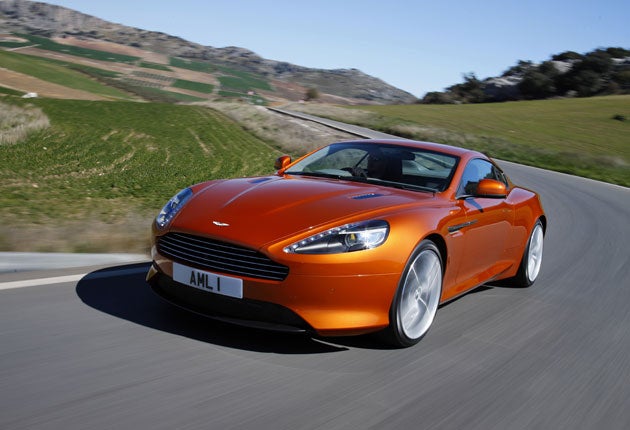Aston Martin Virage
There is much to admire, and enjoy, in the new addition to the Aston Martin DB stable

This seems familiar, you're thinking. Familiar on two levels.
First there's the shape – it's an Aston Martin DB9, isn't it, but very subtly different? Then there's the name, lacking the DB initials because it's that of an early-1990s Aston Martin which looked brutal, promised much but didn't quite deliver.
No, it was worse than that. I drove a Virage Volante (a convertible) back in the day, and I was shocked. It was slow, stodgy and wobbly, with a lumbering, truck-like demeanour and a fearsome fuel thirst. If this was the best that Aston Martin could do, the company was doomed.
Today's Aston Martins are far removed from those embarrassing forbears, and indeed the V8 Vantage S recently reviewed here is one of the most enjoyable racetrack-flavoured GT cars you can buy. The DB9, now seven years old, has had a recent refresh and feels the best it has ever felt. The DBS is a sort of DB9-on-a-drugs-cocktail, very fast but hard-edged and frankly annoying over imperfect road surfaces. It's an imperfect car. And now we have the Virage.
Giving it a separate name, instead of calling it something like DB9 GTS, is supposed to emphasise a separate identity. That the name is tainted in some memories appears to worry Aston Martin not at all. So what, then, is this car whose name means "bend" in French? It sits between the DB9 and the DBS, as a more "focused" GT than the DB9, so that a keen driver will have a more thrilling time in it, but without the battering and occasional annoyance he or she would get from the tetchy, physical DBS.
The 5.9-litre V12 engine produces 497bhp sent through a DB9-style six-speed automatic gearbox. Paddle-shifters, fixed to the steering column instead of moving with the steering wheel, allow manual shifts which blip-up the engine speed during a downchange to help smooth the shift.
So far, so not very different. The Virage also has the adaptive suspension dampers introduced with the DBS, in which selectable Normal and Sport modes each have five automatically-changeable settings within their respective ranges of damping. So the dampers are moving from suppleness to quite tight control of movements, as required, in Comfort mode, while in Sport mode the automatic adaptation is from firmish to a near-iron grip. Thankfully, however, Sport never turns practically solid as it does in the DBS, nor does Comfort allow the tail to float around as it does in the older car.
Same principle, then, but new calibrations and a better execution. The Virage goes one better than the DBS in its steering, too, which uses a more quickly-responding mechanism.
And have you spotted the styling changes? There's a new front grille, new front wings with a subtle channel along their top edges, new flared-out sills with doors reshaped to suit, and rear wings slightly flared to cover the 20in wheels. It looks assertive, but not overtly so.
Is it worth all the effort? It most certainly is, because this is a much more pleasing car than either the DB9 or the DBS. It has a light-footed keenness to its cornering, with crisp, alert steering and a bump-supple but tautly-controlled ride. Comfort mode is fine most of the time, but Sport mode is entirely bearable unless bumps are really bad and is the setting of choice if you're really pressing on.
You feel completely confident in the Virage, always in control, never intimidated despite a 4.6-second 0-62mph time, a potential 186mph top speed and a fabulous bass-leavened howl from the exhaust when you're drilling far into those power reserves. The gearchange works well enough in automatic form but is sufficiently alert, especially in its own, separate Sport setting, to let you enjoy the manual mode. This is a car which feels properly connected to its driver, and as such is the best of all the V12 DB-type cars.
Snags? The boot is small, the rear seats are smaller and it costs a heady £149,995. That makes it too expensive for what you get, but that still doesn't stop the beautifully-made Virage from being a truly lovely device. Unlike its eponymous ancestor.
The Rivals
Bentley Continental GT: £135,760, 575bhp, 384g/km
Recent makeover means less weight, more power from W12 engine and much-improved handling. V8 arrives soon.
Ferrari 599 GTB Fiorano: £212,016, 620bhp, 415g/km
Ludicrously indulgent at that price and CO2 score, but amazingly rapid with fabulous handling. One of the best Ferraris ever.
Porsche 911 Turbo: £110,232, 500bhp, 272g/km
As with Bentley, the power goes via four-wheel drive. Feels neat, compact, sensationally rapid, everyday-usable.
Subscribe to Independent Premium to bookmark this article
Want to bookmark your favourite articles and stories to read or reference later? Start your Independent Premium subscription today.

Join our commenting forum
Join thought-provoking conversations, follow other Independent readers and see their replies